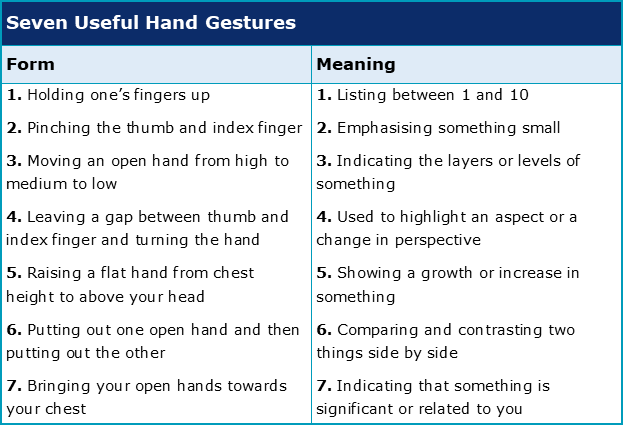What is effective body language in a presentation?

This is the second of three chapters about Body Language. To complete this reader, read each chapter carefully and then unlock and complete our materials to check your understanding.
– Focus on tips for successful body language when presenting
– Introduce six tips for success that students can practise
– Provide examples, scenarios and tables to guide the reader
Before you begin reading...
-
video and audio texts
-
knowledge checks and quizzes
-
skills practices, tasks and assignments
Chapter 2
Chapter 1 of this short reader on body language covered the basics of what body language is in a presentation and why it’s important. This second chapter on the topic next introduces six strategies to help guarantee that your facial expressions, gestures and positioning on stage all help to improve the engagement of your audience and, if your performance is assessed, increase your grade. In addition to the following strategies, students may also wish to study Academic Marker’s short readers on delivery strategies, presentation language and using visual aids.
Six Tips for Success
1. Dress Appropriately
While it may not exactly be an aspect of body language, the clothes that a presenter wears are very important when delivering a presentation – particularly when being assessed or during a business proposal. Gauge your audience and consider your clothing carefully, with formal items being recommended over casual wear. While you don’t necessarily have to be dressed in your smartest attire, it’s certainly not a good idea to perform in torn items of clothing – or your pyjamas! Don’t forget also to consider aspects of general hygiene, making sure to wash, trim, shave and apply something nice smelling. Although the front row of your audience are there to listen to your words, they might also be able to smell you too.
2. Face the Audience
A fairly obvious rule that many young presenters manage to get wrong is that the presenter should face their audience at all times, using a cautious but confident amount of eye contact to directly engage everyone watching. If you have a PowerPoint presentation and you wish to gesture to your slides, then don’t turn your back on your audience; instead, make sure to maintain an open but side-on stance so that you’re mostly facing your audience while also turning slightly towards your visual aid.

3. Consider Your Posture
Posture, which is the overall stance of your body, is quite strongly linked with a person’s emotions. Boredom, anger, confidence – these are all noticeable from the way a person sits or stands. An audience member sitting towards the back of their chair, leaning forwards and nodding along with their hands held together, for example, is one that’s open and ready to listen or contribute to the discussion. From the presenter’s perspective, it’s generally a good idea to adopt a confident posture. A good stance might be to stand up straight and broaden your shoulders, putting your hands beside or behind you and opening your body up to your audience. Do this and you should sound, feel and look more assured when delivering your presentation.
4. Vary Your Gestures
Our fourth tip for successful body language during a presentation is to incorporate careful and controlled hand gestures when talking – and to remember to vary them appropriately. Some studies have found that hand gestures can increase the value of a speaker’s message by a considerable degree. Such gestures are, in fact, a natural part of speech reinforcement, and they may encourage listeners to pay more attention to what you’re saying than you realise. It’s important however that a presenter knows precisely how to best use the many gestures available to them, making sure they’re not too stiff or expressive in how their body moves. To help you in this area, we’ve provided some of the most useful gestures below:

5. Use Open Hand Gestures
As a continuation of the previous strategy, when using hand gestures don’t forget to keep your hands firmly open. A pointed finger, particularly one aimed directly at another person, can seem aggressive or confrontational. Instead, by opening your palms and spreading your hands out wide, you will appear more relaxed as a speaker – and your audience should feel more relaxed too. You can still gesture towards a person directly of course, just remember to do it with open palms.

6. Control Your Facial Expressions
We all make facial expressions without even thinking about it, but learning to control them, exaggerate them, and match them to the content of our presentation can be somewhat more challenging – particularly for new presenters. Smile as a general rule, especially when beginning and ending your presentation. The more serious facial expressions can be saved for the content of your talk when you may wish to communicate that careful attention is required.
A single cocked eyebrow, for example, could be used to indicate surprise or intrigue, while the combination of a furrowed brow and pursed lips might be useful for showing confusion. The more control you have over the minute movements of your face, the more collected and assured you will seem as a presenter.
Downloadables
Once you’ve completed all three chapters about body language, you might also wish to download our beginner, intermediate and advanced worksheets to test your progress or print for your students. These professional PDF worksheets can be easily accessed for only a few Academic Marks.
Collect Academic Marks
-
100 Marks for joining
-
25 Marks for daily e-learning
-
100-200 for feedback/testimonials
-
100-500 for referring your colleages/friends